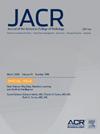Medical Extended Reality for Radiology Education and Training
IF 4
3区 医学
Q1 RADIOLOGY, NUCLEAR MEDICINE & MEDICAL IMAGING
引用次数: 0
Abstract
Medical extended reality (MXR), encompassing augmented reality, virtual reality, and mixed reality (MR), presents a novel paradigm in radiology training by offering immersive, interactive, and realistic learning experiences in health care. Although traditional educational tools in the field of radiology are essential, it is necessary to capitalize on the innovative and emerging educational applications of extended reality (XR) technologies. At the most basic level of learning anatomy, XR has been extensively used with an emphasis on its superiority over conventional learning methods, especially in spatial understanding and recall. For imaging interpretation, XR has fostered the concepts of virtual reading rooms by enabling collaborative learning environments and enhancing image analysis and understanding. Moreover, image-guided interventions in interventional radiology have witnessed an uptick in XR utilization, illustrating its effectiveness in procedural training and skill acquisition for medical students and residents in a safe and risk-free environment. However, there remain several challenges and limitations for XR in radiology education, including technological, economic, and ergonomic challenges and and integration into existing curricula. This review explores the transformative potential of MXR in radiology education and training along with insights on the future of XR in radiology education, forecasting advancements in immersive simulations, artificial intelligence integration for personalized learning, and the potential of cloud-based XR platforms for remote and collaborative training. In summation, MXR’s burgeoning role in reshaping radiology education offers a safer, scalable, and more efficient training model that aligns with the dynamic healthcare landscape.
用于放射学教育和培训的医学扩展现实。
医学扩展现实(MXR)包括增强现实(AR)、虚拟现实(VR)和混合现实(MR),通过在医疗保健领域提供身临其境、互动和逼真的学习体验,为放射学培训提供了一种新的模式。虽然放射学领域的传统教育工具必不可少,但有必要利用 XR 技术的创新和新兴教育应用。在学习解剖学的最基本层面,XR 已得到广泛应用,重点强调其优于传统学习方法,尤其是在空间理解和记忆方面。在影像解读方面,XR 通过提供协作学习环境和加强影像分析与理解,促进了虚拟阅览室概念的发展。此外,介入放射学中的图像引导介入治疗在 XR 的使用上也有所上升,这说明 XR 在安全、无风险的环境中为医学生和住院医师提供程序培训和技能学习方面非常有效。然而,XR 在放射学教育中仍存在一些挑战和限制,包括技术、经济、人体工程学以及与现有课程的整合。本综述探讨了 MXR 在放射学教育和培训中的变革潜力,以及 XR 在放射学教育中的未来发展前景,预测了身临其境模拟、用于个性化学习的人工智能集成以及基于云的 XR 平台在远程和协作培训方面的潜力。总之,MXR 在重塑放射学教育方面的蓬勃发展提供了一种更安全、可扩展和更高效的培训模式,与动态的医疗保健环境相一致。
本文章由计算机程序翻译,如有差异,请以英文原文为准。
求助全文
约1分钟内获得全文
求助全文
来源期刊

Journal of the American College of Radiology
RADIOLOGY, NUCLEAR MEDICINE & MEDICAL IMAGING-
CiteScore
6.30
自引率
8.90%
发文量
312
审稿时长
34 days
期刊介绍:
The official journal of the American College of Radiology, JACR informs its readers of timely, pertinent, and important topics affecting the practice of diagnostic radiologists, interventional radiologists, medical physicists, and radiation oncologists. In so doing, JACR improves their practices and helps optimize their role in the health care system. By providing a forum for informative, well-written articles on health policy, clinical practice, practice management, data science, and education, JACR engages readers in a dialogue that ultimately benefits patient care.
 求助内容:
求助内容: 应助结果提醒方式:
应助结果提醒方式:


